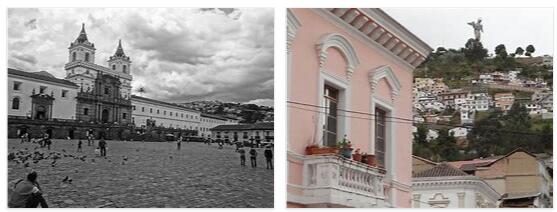The old town of Quito (World Heritage) is one of the best preserved colonial cities in Latin America. Quito was one of the most important cities of the Inca Empire (Inca). After its destruction in 1534, the city was re-founded by the Spanish conqueror S. de Benalcázar on the ruins of the Inca city. With its historical facades and buildings, it reflects the atmosphere of the Spanish colonial era. Visit clothesbliss.com for Ecuador and the galapagos.
Old Quito: Facts
| Official title: | Old Quito |
| Cultural monument: | Not far from the 4776 m high volcano Pichincha, former capital of the northern Inca empire, with 30 churches and monasteries once an important starting point for proselytizing, “baroque jewel of the Andes” with the city plan in the form of a checkerboard pattern |
| Continent: | America |
| Country: | Ecuador |
| Location: | Capital of Ecuador located at 2850 m |
| Appointment: | 1978 |
| Meaning: | the best preserved and least modified old town in Latin America and a harmonious amalgamation of different baroque and local architecture |
Old Quito: History
| 1492 | Kingdom of Quito falls to the Inca |
| 1534 | Founded by the Spaniards on the ruins of the Inca city |
| 1597-1765 | Jesuit Church La Compañía de Jesús |
| 1809 | Signing of the declaration of independence, which is only valid for a few weeks, in the monastery of San Augustín |
| 1976 | Monument protection for the old town |
| 1987 | Damage to the historic old town due to earthquakes |
Open-air museum at the foot of the fire mountain
Nobody could blame it if admission was charged on the approach, because like a huge open-air museum, Quito squeezes into the Andean valley in the shadow of the Pichincha.
What can already be guessed from the air is confirmed in the old town center of the Andean metropolis: white lime on the facades, blue shutters and bleached bricks are colored mosaics in the checkerboard pattern of the streets. Stucco decorations over the windows, brick and wrought iron balconies adorn the houses. In their simple beauty, mansions surprise with playful bay windows, shady arcades and courtyards decorated with fountains. Quito – after La Paz, the second highest “Capital del mundo” – has remained Andalusian to this day with its somewhat Indian flavor. Barefoot porters drag their heavy loads on crooked backs in the streets. Indian women with the typical “man’s hat” keep an eye on their goods, on avocados and pineapples. Corn and bananas are roasted on improvised fireplaces.
The colonial splendor, however, overwhelms the feudal palaces, monumental monasteries and the richly decorated churches that dominate the cityscape in a very small space. La Compañía de Jesús is the baroque jewel among the houses of worship in South America. When you visit, you take a trip back to the Baroque and the Renaissance: Even the facade with columns, arches and statues, which plays with light and shadow, expresses a bewildering vibrancy. The main altar, although not carved in andesite, but worked in wood, continues this liveliness. As soon as you enter the church, your gaze falls on the wooden ceiling decorated with gold leaf. The glory, however, ignites like fireworks on the high altar, the gold of which breaks through the semi-darkness.
Just a stone’s throw away from the cathedral, consecrated in 1572, San Francisco juts out of the sea of roofs. Once the world’s largest monastery complex, the “Escorial of the Andes” took up four blocks. As early as 1581, the church with its relatively simple Renaissance facade and atrium-like porch was praised as the most noble in the kingdom. Inside, emeralds, gold and silver sparkle. In a playful frenzy, artisans created the carved choir stalls for 81 monasteries. Late Gothic pointed arches harmonize with the Baroque of the high altar.
La Merced rises like a fortress, an impressive monastery with a clock tower, a “twin sister of Big Ben”. Although you enter a house of worship, the sun and moon carved into stone at the entrance portal reveal pagan influences. The interior design, which is characterized by Moorish architecture, did not skimp on 24-carat gold leaf.
The “metropolis of the four seasons” was the first city in South America to demand its independence. The first unilateral declaration of independence was signed on August 10, 1809 in the “Golden Convention” of San Augustín, which is why Quito proudly calls itself the “Light of America”. But this explanation was without consequences. It was not until 13 years later that Republican units defeated with the battle cry “Long live the fatherland! – Down with the king! ”Associations loyal to the king and enforced the long-awaited independence.
